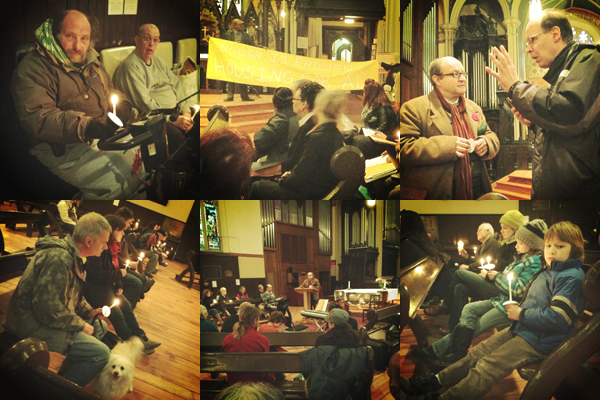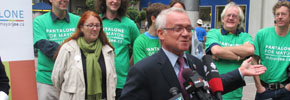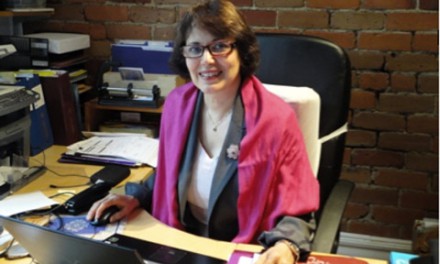Sima Sahar Zerehi – There’s a tradition in Iran, it’s related to how we mark Nowruz, our New Year. Just before the official celebrations start with Chaharshanbe Suri, the fire festival that launches the festivities, we prepare our homes, by doing a thorough spring-cleaning or Khoone Takouni. This is no ordinary dust and polish but a floor to ceiling, basement to attic, under the rug, behind the forgotten piles in the closet kind of affair.
Like many immigrant kids growing up outside of my country of birth, I got to pick and choose which traditions I wanted to incorporate into my Canadian life. Being a pack rat, with an abundance of mementos, I always dreaded the annual spring-cleaning. I cringed as my meticulous mother would sift through my drawers and shelves forcing me to evaluate my prized collection of political buttons, newspaper clippings or art show catalogues, her raised eyebrows reducing my lovingly accumulated stash to piles of worthless junk. When I finally moved out of my parents’ home to go to university I decided to forego this cumbersome annual ritual. Tradition be damned, it’s my house and I’ll clean when I want to.
But customs have a way of haunting you. This year as I sat down to write my annual Nowruz article, I kept on feeling like something was amiss. I would type a few notes and try to collect my thoughts, but something kept nagging at me. I wanted to think of spring, of rebirth, I wanted to celebrate family and friends and traditions that make me feel rooted as an Iranian, even though I have been years and oceans away from my homeland, but instead I felt distracted, encumbered, weighted down.
I was despondently scrolling through my Twitter feed searching for inspiration when I finally realized what was amiss. I was sifting through posts about Toronto’s shelter report and its conclusion that we don’t need any more beds, versus photos posted by a friend the night before of people sleeping on the streets in the East End, (during a 20 minute walk, he had spotted over six huddled bodies on the street on a cold damp night). Then it dawned on me, I couldn’t think of spring with my house in disarray.
True my closets could use an overhaul, and as always my bookshelves are brimming with too many files, folders and loosely stacked piles of paper, but it wasn’t my house that was mentally blocking me, it was the state of my city.
Since I left Iran as a seven year old, I have lived in a number of countries and cities, in most places, even the places I’m fond of like Rome or New York, I have felt like an outsider or traveller, but for many years now, Toronto has been home. Even before I felt comfortable calling myself a Canadian, I started thinking as a Torontonian; this city gets me, it’s accented streets, its schizophrenic neighbourhoods, its hyphenated identities. My coming of age story is mapped along the corridors of the GTA stretching from Yonge Street north to Richmond Hill and west on Bloor to Mississauga. I learned to think in the second hand bookstores scattered around University of Toronto. My secrets are whispered in the back alleys of the Annex, my community beats in the heart of Mel Lastman Square, my heart was broken in Trinity Bellwood’s Park and I found friendship walking all the way east to Richmond street on a cold winter night.
If my Toronto was in disarray then there was no spring for me. It wasn’t just the fact that our mayor and his team were refusing to acknowledge the housing crisis in this city, it was the realization that a he said, she said, story about two city elites behaving badly was taking up more air and ink than the growing list of people freezing to death due to a shortage of shelter beds.
I want to celebrate rebirth and the promises that come with a new year but first allow me a chance to use my pen and ink to do some spring cleaning. After all, Toronto is my home, and Tehranto is my house, and to get this place ready for a party I need to clear out the trash.
Homeless Memorial Vigils
I used to be a regular attendee at the monthly homeless memorial vigils held at the Church of the Holy Trinity nestled behind Toronto’s Eaton Centre. Housing advocates and front-line workers would join people living on the streets to recite the names of those who had died homeless on Toronto’s streets. If a name was read that someone recognized, they would take the opportunity to say a few words about them, a eulogy of sorts. Often names were read without anyone stopping to say anything, at other times someone would add the story of another death without having a name to attach to the person.
After a while I stopped going to the vigils. I found the whole affair depressing, to imagine anyone freezing to death because of lack of shelter beds in a country as rich as Canada seemed incongruous. To be reminded of this fact steps away from the Eaton Centre as happy shoppers totted bags of luxury goods felt even more surreal.
But this morning with a need to do some spring-cleaning I headed out to the church. With rain in the forecast the vigil was moved indoors, the church was filled with people holding candles. Many were friends of those who had died on the street, a few were activists coming to support the cause or members of the church community coming to lend a hand.
The customary names of the deceased were read and people stood up to share a few words. This time there was more than sadness in the air, the crowd had an edge of anger. At one point someone unfurled a banner that said “Enough is Enough, Housing for All.” No one chanted, or clapped, it wasn’t that kind of gathering, but many had clenched jaws and fists. Any mention of the city’s report was met with furious shakes of the head and sharp intakes of breath. The speaker announced that two more names were added to the list of people who had died on the street since last month, the attendees hissed in disgust.
Setting the Record Straight
I spotted John Clarke a pioneer among housing advocates from the Ontario Coalition Against Poverty in the crowd; he was sitting on the side, head bowed, and deep in thought. I cornered him after the choir ended the gathering with a rendition of Blowing in the Wind and asked him about his thoughts on the City’s report on shelter beds.
“The report is part of a long tradition of bureaucratic fantasy and cover-up that the city uses to try to perpetuate this myth that there are plenty of shelter beds. The reality comes back anecdotally from the people on the streets themselves, from front-line advocates and from people who carry out studies on this situation, and everyone is aware that people are being turned away from shelters,” exhaled John in a single breath as through he had been constructing the answer for hours and waiting for a chance to set the record straight.
John cited a number of studies that contradict the city’s contentious report including one conducted by Street Health in 2007 when the homelessness situation was in less of a crisis. He noted that even at that time the findings spoke of the need for additional shelter beds in Toronto.
He also questioned the methodology behind the recent report produced by the city, “The report acknowledges that they did their check at 4 in the morning hours after the scramble for beds is over and people have already been turned away.”
“Earlier in the evening like at 6pm people are scrambling to find a bed, they’re going to referral centres or waiting indefinitely to hear if a given shelter has a free bed, advocates are desperately calling looking for spots for clients. At 4am it’s all over people have given up and have left to sleep on benches and in the streets, it’s comparable to a ship sinking and than hearing hours later that there were a few spots for additional passengers on the lifeboats.”
“Even if everything the city is saying is true and they are in fact running at 96% capacity, that still excludes some people because many can’t accept the conditions because of the dangers they face in overcrowded shelters, others are barred because the frustration over tension and violence, these inhumane conditions of overcrowding are unacceptable.”
Speaking about how the system is functioning, John notes, “We hear people going down to the Peter street referral centre and waiting all night long and ending up sleeping in chairs or on the floor.”
Clearly exasperated he says, “When we’re talking about shelters we’re talking about the last thing this society provides before it abandons you, we’re talking about something by definition degrading and insulting. Unfortunately the crisis has reached such a level in Toronto that we have to even fight for something that we should be phasing out, but they’re not providing housing and now they’re not providing shelters either.”
“I think we have to recognize that the denial of adequate shelter space is very much linked to the agenda of austerity, the ultimate expression of social cutbacks is to put people homeless on the streets,” he says in conclusion.
Another attendee speaking to a fellow journalist from Rabble is Michael Shapcott, currently the Director of Housing and Innovation at the Wellesley Institute, I remembered him from his days leading the Toronto Disaster Relief Committee.
Michael echoes John’s assertions about the findings in the report.
“Just last week Social Planning Toronto put out a very credible set of numbers based on a limited survey of 15-16 homeless shelters, every one of those shelters reported that at least once in the previous month they turned people away,” explains Michael.
“The city in their report says they only received one complaint, but if someone doesn’t have access to a shelter they don’t have access to a phone, or computer to file a complaint. I don’t think that just because they received one complaint means that nobody is being turned away.”
Michael explains other reasons why the report’s conclusions are questioned by experts in the field, “I’m not sure when the report talks of open spots in shelters they are talking about real beds, in some cases they may be talking about a no-show or a mat on the floor.”
Speaking of spaces in shelters Michael notes that spaces for certain populations like families or new immigrants are also limited, forcing people to separate from each other to secure a bed or to go to a place that doesn’t meet their specific needs.
Michael also points out that the fight for more shelter beds and emergency responses to over capacity is far from new. “Back in the late 1990s one of the reasons we fought for the policy of opening more spaces when 90% of the official occupancy beds were filled was because we realized that you need to have the capacity in the system more than filling every single bed before declaring an emergency. The city did follow that policy for a few years before falling back again. In the 2013 budget they’re proposing less funds for shelter beds and when asked why they anticipate less need for beds they have no answer.”
“Every social and economic trend shows that things are getting worse and there are more people getting on the streets,” warns Michael.
When asked what can be done to improve the system, he responds, “The city has spent millions of dollars on a shelter management information system that has yet to provide the kind of service utilization that will let us have an intelligent conversation about numbers, what we need to look at is the results over time.”
He posits the New York model as an alternative, “New York’s Department of Homeless Services has a website. Every morning they post information on the exact number of people that are in the shelter system in New York city and they also have historical information that goes back 10-20 years. The important of these numbers is that you can spot trends.”
“A few months ago they noticed there’s a spike in the number of seniors using shelters in New York City that caused people to pay attention to the needs of this population for housing. More recently the startling statistic that came out was that that there are currently more people on a nightly basis in the shelter system than at any other time except during the Great Depression. Having the service utilization numbers with daily tracks that allow people to monitor these numbers publicly make it possible to understand these trends. We don’t have that in Toronto, we have these highly defensive reports that say on this particular night we have 100 beds here or there,” concludes Michael.
As people mill about grabbing plates of a home cooked hot lunch and a cup of coffee prepared by the church, I hear John and a few other OCAP activists in a corner discussing the upcoming meeting at City Hall where they will lobby for opening more emergency shelter beds when at 90% capacity.
People like John and Michael have been in this fight for decades, they have made the same arguments year after year, reintroducing the same policies every few years to new city officials, still you can hear the passion and indignation in their voices.
These places where people gather to remember. These people who fight alongside individuals who are most marginalized. These communities of resistance and hope are why I love Toronto, and why my Tehranto spring cleaning starts with a look at City Hall and how we can do better.
_____________________________________
For more information see:
City of Toronto Report on Emergency Shelter Services http://app.toronto.ca/tmmis/viewAgendaItemHistory.do?item=2013.CD19.1
NYC Department of Homeless Services website: http://www.nyc.gov/html/dhs/html/home/home.shtml
OCAP’s work on homelessness and housing http://update.ocap.ca/housing
Wellesley Institute’s work on housing http://www.wellesleyinstitute.com/our-work/housing/http://update.ocap.ca/housing







Wow! Thank you Thank You THANK YOU for this thorough, thoughtful, and unique engagement with the shelter crisis here in Toronto.